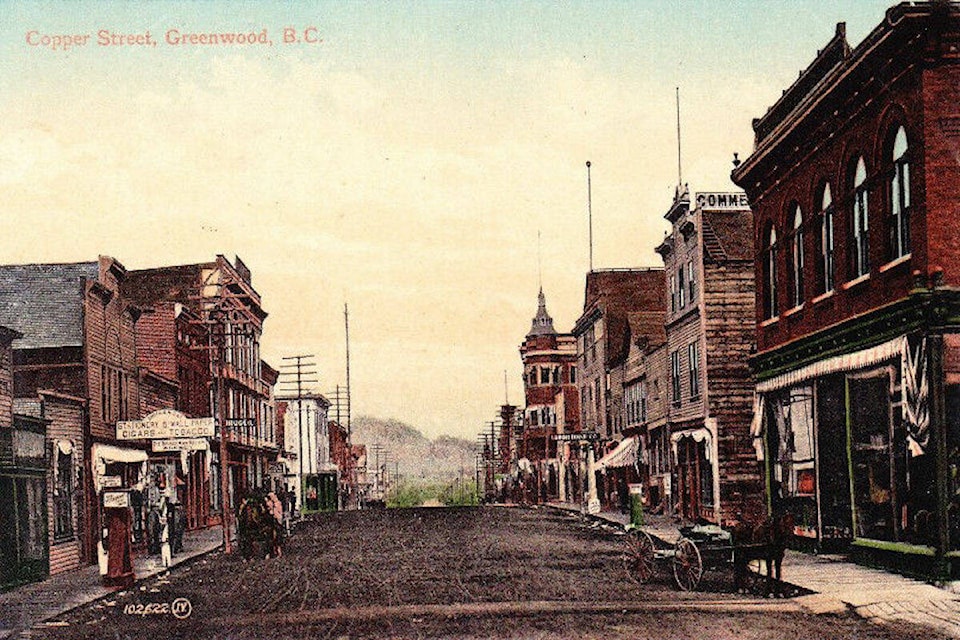A column by Bruce Uzelman
The scene: Southern British Columbia at the turn of the last century. Mining towns often sprang up and disappeared over the course of just a few decades. Some, like Fernie and Nelson, survived to prosper again. Some, like Sandon and Phoenix, peaked over one hundred years ago, and vanished.
The City of Phoenix thrived for two decades, only to be abandoned virtually overnight. Phoenix adjoined a large copper deposit and mine. After the price of copper collapsed in 1918, the mine’s owner, Grandby Consolidated Mining, Smelting and Power, closed it. By 1920 the city was empty. A later pit mine obliterated everything. The site of the once bustling community became only a crater.
Greenwood, down the road from Phoenix, fared better. It survived. The elegant period architecture, the significant brick and wood buildings on Copper Avenue, the impressive Court House, now the City Hall, and the stately Post Office all tell a story. This was a substantial, prosperous city.
The first ranchers and placer miners arrived in the Boundary District in the late 1850s and early 1860s. The district lay between the Okanagan and the West Kootenay. Prospecting and small scale hard rock mining began in the late 1880s and the early 1890s. The first mineral claims were staked in 1884, but mining at scale was very difficult due to the lack of wagon roads and railroads.
American prospectors streamed into the Boundary in 1893, and a provincial government road was built from Penticton to Grand Forks in 1894. Several mining camps were soon operating.
An enterprising businessman from the Okanagan, Robert Wood, arrived to assess opportunities in the Boundary. A bio written in 1905 appeared in the book, British Columbia from the Earliest Times to the Present. “In 1895, coming to the present site of Greenwood … he [Wood] was very much impressed both by the resources of the mineral area and the natural advantages offered for a town site.” Wood purchased the land and, “at once began the work of laying out a new town.”
By the fall of 1896, Greenwood already had three hotels, and more were added in 1897. The B.C. Mining Record wrote, “Hardly a year old, the town now boasts of general mercantile stores carrying as full a line of supplies as any in the interior, and nearly every branch of business and profession is represented.” (Newspaper quotations are from www.beautifulgreenwood.com/features.)
Greenwood was incorporated as a city in 1897. By 1899, the population reached 3000. In 1900, the city contained eight hotels, two dozen or more stores and suppliers, two banks, two newspapers, two lumber yards, four breweries and distillers and a large variety of services.
The Canadian Pacific Railroad reached Greenwood in 1899. Spur lines were soon constructed to several mining camps. And numerous wagon roads linked mines and camps to the provincial road.
Optimism was in the air. “Greenwood is and will continue to be the commercial as well as the mining and manufacturing centre of this great district, with lumbering interests enough alone to create a city and mineral wealth sufficient to create an empire,” the Greenwood Times declared.
There was some hyperbole there, but it was a promising time. The Times noted “the hundreds of mines,” “the thousands of miners” and “the smelters and mills.” Sixteen mining camps were active in the Boundary in 1900. Most camps were near Greenwood, and most served a number of mines. The B.C. Copper Company smelter, arguably Greenwood’s most prized asset, opened in 1901.
Residents, and certainly the Greenwood Times, expected the boom would continue indefinitely. Of course, that could not happen. Eventually the mines were exhausted and closed, and the city’s population began to melt away. The smelter closed too in 1918. Grand Forks, over time, replaced Greenwood as the commercial center of the Boundary.
But Greenwood continued to be a viable community. It is situated in a beautiful area of the province, and it retains a rich history. The smallest city in Canada only lacks economic renewal.
There are some signs of recovery though. On the city’s 125th birthday in 2022, Mayor Barry Knoll argued that, though Greenwood relies on the timber industry, it is becoming a retirement center. He added, “We’ve had a lot of interest in the last couple of years and … a lot of interest in rural living.” He mused, “there is always ore in the hills. That hasn’t gone. They didn’t get it all out. You never know what will happen. It may become a mining area again.”
A mining area again? That may or may not be likely, but it is intriguing, just as it was circa 1895!

Bruce W. Uzelman, based in ��������, holds interests in economics and political science.



